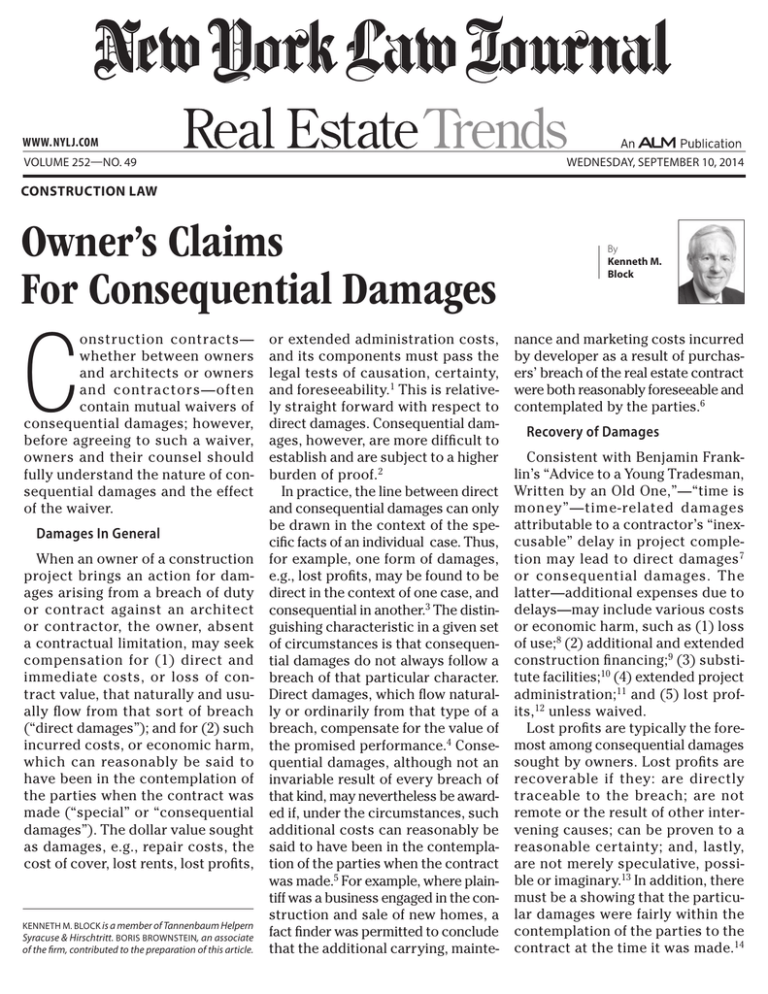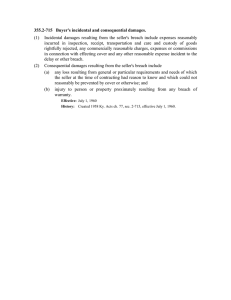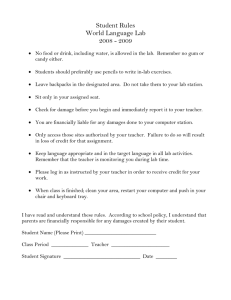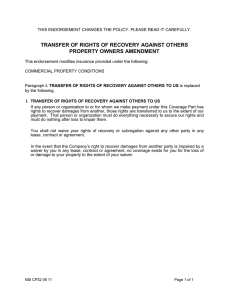
www. NYLJ.com
wednesday, september 10, 2014
Volume 252—NO. 49
Construction Law
Owner’s Claims
For Consequential Damages
C
onstruction contracts—
whether between owners
and architects or owners
and contractors—often
contain mutual waivers of
consequential damages; however,
before agreeing to such a waiver,
owners and their counsel should
fully understand the nature of consequential damages and the effect
of the waiver.
Damages In General
When an owner of a construction
project brings an action for damages arising from a breach of duty
or contract against an architect
or contractor, the owner, absent
a contractual limitation, may seek
compensation for (1) direct and
immediate costs, or loss of contract value, that naturally and usually flow from that sort of breach
(“direct damages”); and for (2) such
incurred costs, or economic harm,
which can reasonably be said to
have been in the contemplation of
the parties when the contract was
made (“special” or “consequential
damages”). The dollar value sought
as damages, e.g., repair costs, the
cost of cover, lost rents, lost profits,
Kenneth M. Block is a member of Tannenbaum Helpern
Syracuse & Hirschtritt. Boris Brownstein, an associate
of the firm, contributed to the preparation of this article.
or extended administration costs,
and its components must pass the
legal tests of causation, certainty,
and foreseeability.1 This is relatively straight forward with respect to
direct damages. Consequential damages, however, are more difficult to
establish and are subject to a higher
burden of proof.2
In practice, the line between direct
and consequential damages can only
be drawn in the context of the specific facts of an individual case. Thus,
for example, one form of damages,
e.g., lost profits, may be found to be
direct in the context of one case, and
consequential in another.3 The distinguishing characteristic in a given set
of circumstances is that consequential damages do not always follow a
breach of that particular character.
Direct damages, which flow naturally or ordinarily from that type of a
breach, compensate for the value of
the promised performance.4 Consequential damages, although not an
invariable result of every breach of
that kind, may nevertheless be awarded if, under the circumstances, such
additional costs can reasonably be
said to have been in the contemplation of the parties when the contract
was made.5 For example, where plaintiff was a business engaged in the construction and sale of new homes, a
fact finder was permitted to conclude
that the additional carrying, mainte-
By
Kenneth M.
Block
nance and marketing costs incurred
by developer as a result of purchasers’ breach of the real estate contract
were both reasonably foreseeable and
contemplated by the parties.6
Recovery of Damages
Consistent with Benjamin Franklin’s “Advice to a Young Tradesman,
Written by an Old One,”—“time is
money”—time-related damages
attributable to a contractor’s “inexcusable” delay in project completion may lead to direct damages 7
or consequential damages. The
latter—additional expenses due to
delays—may include various costs
or economic harm, such as (1) loss
of use;8 (2) additional and extended
construction financing;9 (3) substitute facilities;10 (4) extended project
administration;11 and (5) lost profits,12 unless waived.
Lost profits are typically the foremost among consequential damages
sought by owners. Lost profits are
recoverable if they: are directly
traceable to the breach; are not
remote or the result of other intervening causes; can be proven to a
reasonable certainty; and, lastly,
are not merely speculative, possible or imaginary.13 In addition, there
must be a showing that the particular damages were fairly within the
contemplation of the parties to the
contract at the time it was made.14
wednesday, september 10, 2014
Claims for lost profits arising out of
delay may be found to be too speculative where the claim for delay itself
is unsubstantiated.15
For example, in Kenford v. County
of Erie,16 the county failed to satisfy
its commitment to negotiate a lease
with the developers for the operation of a stadium and the project was
abandoned. The intended operator
of the stadium sued the county for
the loss of prospective profits during
the 20-year period of the anticipated
management contract. At trial, the
plaintiffs won a multimillion-dollar
judgment. The intermediate appellate court modified the judgment on
the ground that expert opinion did
not provide a rational basis for the
calculation of lost profits. The Court
of Appeals, however, denied consequential damages. A plaintiff seeking lost profits, the Court of Appeals
concluded, must demonstrate that
the “particular damages were fairly
within the contemplation of the parties to the contract at the time it was
made.”17 Finding that the lost profits
award was based on a speculative
assessment of how much income
would be generated by the neverconstructed stadium, the Court of
Appeals held that plaintiff’s proof
failed on the second prong. The
court also found, based on the record
before it, that lost profits damages
had not been within the contemplation of the parties.
In a sequel to Kenford,18 the court
rejected a claim for damages by the
stadium developers for the loss of
anticipated appreciation in the value of land that they had purchased
on the periphery of the proposed
stadium site. The contract stipulated that part of the compensation
paid to the county would consist of
increased real property taxes resulting from the enhanced value that
the peripheral land would enjoy as
a result of the stadium. That clause
suggested that plaintiffs expected
to profit from development of the
land and that breach would deny
the plaintiffs those anticipated profits.19 Nevertheless, the court denied
recovery, reasoning that plaintiffs
could only recover these damages
if they were within the contemplation of the parties as the probable
result of a breach at the time of
contracting. And what was in the
parties’ contemplation depended on
“the nature, purpose and particular circumstances of the contract
known by the parties…as well as
‘what liability the defendant fairly
may be supposed to have assumed
consciously, or to have warranted
the plaintiff reasonably to suppose
that it assumed, when the contract
was made.’” 20 Such a fact-specific
and subjective inquiry is bound to
produce inconsistent results unless
parties marshal evidence bearing
on what they had contemplated.21
Lost profits are typically the
foremost among consequential
damages sought by owners.
A party to a contract also may
recover financing costs as incidental
damages, apart from prejudgment
interest allowable under New York
State law.22 Generally, courts award
such relief where the injured party
can point to costs associated with
a particular loan that was “commercially reasonable and foreseeable”
under the circumstances.23 In New
York, however, claims seeking interest as part of damages rarely succeed because of the limitations on
consequential damages discussed
above.24 Thus, for example, in the
context of mortgage rates, unless
the parties had allocated the risk
of interest rate fluctuating and leading to additional costs as a result
of a culpable delay in performance,
courts may be reluctant to allocate
such risk, and instead find that the
parties had not contemplated such
additional cost.25
Waivers
Sophisticated owners and contractors can easily anticipate most
consequences likely to result from
construction contract breaches.
For this reason, contractors and
design professionals routinely seek
to obtain a waiver of consequential
damages for fear that an imposition
of such damages might have disastrous financial effects, particularly
where there is no insurance coverage for claims of an owner. Determining the waiver’s scope can be
as challenging as determining what
damages are “consequential”—and
thus within the scope of waiver—
which can vary depending upon the
factual circumstances.
This distinction became more
important with the adoption of
the 1997 version of the American
Institute of Architects (AIA) document A-201, General Conditions
of the Contract for Construction.’
Section 4.3.10 of the 1997 version
contains a waiver by the owner and
the contractor of all consequential
damages. The provision states that
this waiver includes:
• damages incurred by the owner
for rental expenses, for losses
of use, income, profit, financing,
business and reputation, and for
loss of management or employee
productivity or of the services of
such persons, and
• damages incurred by the
contractor for principal office
expenses including the compensation of personnel stationed
there, for losses of financing,
business and reputation, and for
loss of profit other than anticipated profits arising directly
from the work.
A waiver of consequential damages
is also found in the AIA forms for
wednesday, september 10, 2014
owner/architect agreements.
Waivers of this nature routinely
have been broadly enforced. In 400
15th Street v. Promo-Pro, owner’s
claim for delay damages was dismissed “because they constitute
consequential damages” and were
thus barred by the contract’s waiver
of consequential damages, where
“a plain reading of the [contract]
reveal[ed] that it applied to all ‘consequential damages arising out of
or relating to this contract.’”26
In the contractor context, a waiver
may leave the owner bereft of a remedy for delayed construction in the
form of lost revenue and increased
carrying costs. While liquidated
damages may substitute for consequential damages (to the extent
they approximate delay damages
suffered), contractors are equally
loath to agree to assume that obligation. An alternative approach may
be simply to limit the amount of consequential or liquidated damages
recoverable to a tolerable range.
Consideration should also be given to restricting the waiver to first
party claims between the owner and
contractor, which are not covered
by general liability insurance.
However, there should be no waiver of consequential damages arising
from a third-party action against an
owner arising from negligence or
breach of contract by the contractor
because such claims are generally
covered by the contractor’s general liability insurance. Additionally,
where a non-party to a construction
contract brings allegations sounding only in tort, absent contractual
rights and privity, recovery is permitted only for losses from tortious
invasion that cause personal injury
or property damage to plaintiff. 27
The calculus with respect to design
professionals is a bit different. Unlike
contractors carrying only general
liability insurance (which, as noted, does not provide coverage for
first-party claims), architects also
carry professional liability insurance, which will cover claims for
consequential damages by an owner
against an architect. A reasonable
balance may be to limit the architect’s liability for consequential
damages to the amount of insurance
being carried. Owners, however,
should proceed cautiously, for the
architect’s insurance coverage may
be eroded by multiples claims.
While waivers are common
place and broadly enforced,
the full ramification of the
waiver should be understood
as possibly leaving an aggrieved owner without a complete remedy for damages
flowing from the breach.
Conclusion
Under appropriate circumstances,
consequential damages for breach
of construction contracts are recoverable if foreseeable in nature and
not waived. While waivers are common place and broadly enforced, the
full ramification of the waiver should
be understood as possibly leaving
an aggrieved owner without a complete remedy for damages flowing
from the breach. Thus, care should
be taken in agreeing to the waiver
and negotiating its full terms.
••••••••••••••••
•••••••••••••
1. See, e.g., Glens Falls Ins. v. Quality Furniture, 301 A.D.2d
626, 754 N.Y.S.2d 346, 347 (2003).
2. See, e.g., Compania Embotelladora Del Pacifico, S.A. v.
Pepsi, 650 F. Supp. 2d 314, 322 (S.D.N.Y. 2009) (addressing
whether the breach of contract damages sought by the plaintiff “are general, thus merely requiring a “reasonable estimate’
of damages before an award can be made, or instead consequential, thus requiring CEPSA to prove such damages ‘with
reasonable certainty”‘).
3. Compare Am. List Corp. v. U.S. News & World Report, 75
N.Y.2d 38, 42 (1989) (lost profits are direct damages), with
Kenford v. County. of Erie, 73 N.Y.2d 312, 321 (1989) (loss of anticipated profits and loss of anticipated appreciation in value
of land owned in periphery of proposed stadium site are consequential damages).
4. Latham Land I, v. TGI Friday’s, 96 A.D.3d 1327, 1330-31
(2012).
5. Am. Standard v. Schectman, 80 A.D.2d 318, 321 (1981).
6. See, e.g., David Home Builders v. Misiak, 937 N.Y.S.2d 524,
525 (2012) (for the purchasers’ breach of contract, the jury
properly awarded the vendor consequential damages).
7. Lake Steel Erection v. Egan, 403 N.Y.S.2d 387, 389 (1978)
(lost profits for delay in grouting the concrete flooring slabs).
8. Cf. e.g., Cooperstein v. Patrician Estates, 499 N.Y.S.2d 423,
424 (1986) (for breach of contract for construction and sale of
house, home purchasers were entitled to award of damages to
compensate them for contractors’ breach of promise to timely
construct house on premises).
9. Cf. e.g., Bulk Oil (U.S.A.) v. Sun Oil Trading, 697 F.2d 481,
482 (2d Cir. 1983) (citing Neri v. Retail Marine Corp., 30 N.Y.2d
393, 397 (1972)); Long Island Lighting v. IMO Indus., 85 CIV.
6892 RO, 1990 WL 64588 (S.D.N.Y. May 3, 1990) (“a party to a
contract may recover financing costs as incidental damages,
apart from prejudgment interest allowable under New York
State law.”).
10. Cf., e.g., Losei Realty v. City of New York, 254 N.Y. 41, 47
(1930) (landowner could recover, as damages resulting from
city’s delay in filling in property, loss in rental value resulting
from the period of delay reasonably attributable to city).
Manshul
Const.
v.
Dormitory
11.
Cf.,
e.g.,
Auth. of New York, 436 N.Y.S.2d 724, 729 (1981).
12. See Ansonia Brass & Copper v. Gerlach, 8 Misc. 256, 25960, 28 N.Y.S. 546, 549 (Com. Pl. 1894).
13. Kenford v. Erie County, 67 N.Y.2d 257, 261 (1986).
14. Id.
15. Teramo & Co. v. O’Brien-Sheipe Funeral Home, 725
N.Y.S.2d 87, 90 (2d Dept. 2001) (trial court erred in awarding
profits lost due to construction delay; owner’s unsubstantiated claim that it lost business due to the delay in completing construction of the extension to its funeral home was too
speculative to allow recovery).
16. 67 N.Y.2d 257, 261 (1986).
17. Id.
18. Kenford v. Erie County, 73 N.Y.2d 312, 315 (1989).
19. Id. at 317-18.
20. Id. at 319 (quoting Globe Ref. v. Landa Cotton Oil, 190
U.S. 540, 544 (1902)).
21. Route 7 Mobil v. Machnick Builders, 296 A.D.2d 809, 810
(3d Dept. 2002) (rejecting a gas station owner’s claim for four
years of lost profits attributable to water contamination of an
underground diesel fuel tank allegedly improperly installed by
the contractor based on finding that owner failed to offer adequate proof to meet any of the required elements of direct or
consequential damages).
22. See cases cited, supra, note 9.
23. Id.
24. See, e.g., Ernst Steel v. Horn Const, 104 A.D.2d 55, 63
(1984) amended, 109 A.D.2d 1104 (1985) (manufacturer failed
to substantiate its claim that the entire amount of increased
costs due to the delay was paid for with borrowed funds).
25. See Hurley v. Watanabe, 2014 N.Y. Slip Op. 32160(U),
2014 WL 3870614, at *10 (N.Y. Sup. Aug. 5, 2014) (finding that
parties agreement indicated that risk for an interest rate was
not allocated, and in light of the time allotted for performance,
placing such risk on defendant is not warranted).
26. 400 15th Street v. Promo-Pro, 28 Misc. 3d 1233(A), 2010
WL 3529466, at *10 (N.Y. Sup. 2010) (dismissing claims for consequential damages for losses due to the change in the Zoning
Resolution, consisting of delay damages, attorney fees to appeal the zoning change, and its payment of additional interest,
insurance, and other carrying charges.”); see also New York
Trans Harbor v. Derecktor Shipyards Conn., 15 Misc. 3d 1140(A),
2007 WL 1532293, at * 6 (Sup. Ct. 2007) (enforcing waiver of
consequential damages with respect to delay damages).
27. 5th Ave. Chocolatiere v. 540 Acquisition, 712 N.Y.S.2d 8
(1st Dept. 2000), rev’d, 96 N.Y.2d 280, 294 (2001) (reversing
lower court’s allowance of recovery for economic loss, holding that negligence claims seeking recovery of purely economic loss fell beyond the scope of duty owed by reason of city’s
closure of streets for safety reasons to businesses impacted
and area residents evacuated from their homes); Amin Realty
v. K & R Const., 306 A.D.2d 230, 231 (2d Dept. 2003) (denying
a building owner’s negligence claim against a concrete supplier under the economic loss doctrine, and ruling that the
owner did not fall within the third-party beneficiary exception
because “the record is devoid of any evidence that the parties intended that the [building owner] be a beneficiary of the
contract. The [owner], at most, was an incidental beneficiary
of such contract.”); Bri-Den Const. v. Kapell & Kostow Architects, 56 A.D.3d 355, 355 (1st Dept. 2008) (stating the rule that
economic losses could be recovered in a relationship that was
the “functional equivalent of contractual privity,” but rejecting
the claim of a contractor against an architect after finding no
such privity).
Reprinted with permission from the September 10, 2014 edition of the NEW YORK
LAW JOURNAL © 2014 ALM Media Properties, LLC. All rights reserved. Further
duplication without permission is prohibited. For information, contact 877-257-3382
or reprints@alm.com. # 070-09-14-09




